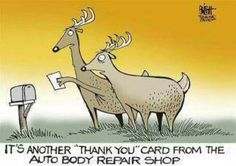
Don’t Let an Accident with a Doe Cost You Lots of Dough
You’re driving down the highway at the end of the day, when all of a sudden you say “Oh Dear?” as a giant head of antlers crashes into your front fender.
You can avoid an accident with a buck – and spending lots of bucks on the damage – by following some smart driving tips this fall and winter. Every year, some 1.5 million drivers hit a deer, and the cold weather months are peak season for deer-vehicle crashes.
Deer crashes result in at least $1.1 billion a year in vehicle damage, according to the Insurance Institute for Highway Safety. On average, the collisions cost $3,305 per insurance claim, and up to $10,000 if there is injury to the driver or a passenger, according to the Insurance Information Institute.
The Risks Aren’t Just in Rural Areas
The top states for deer-related accidents in 2017 range throughout the country, and no longer are these accidents relegated to rural areas. The top 10 deer danger states are:
1. West Virginia
2. Montana
3. Pennsylvania
4. Iowa
5. Wisconsin
6. South Dakota
7. Minnesota
8. Wyoming
9. Michigan
10. North Dakota
As migration and mating season hit full swing, the dangers rise, making October through December the most treacherous months on the road where deer are concerned.
Drive Defensively to Avoid Deer Dangers
Early morning and dusk are the worst times for deer accidents, as visibility is limited and deer are frequently on the move. It is important to drive defensively and anticipate the potential for deer in the road so you can safely stop and avoid the accident.
The auto experts at Randy & Bob’s Auto Body, who repair thousands of vehicles each year from deer-related accidents, offer the following tips to reduce the deer danger:
1. Use extra caution at dawn and dusk, and around golf courses, fields and wooded areas.
2. Remember that deer travel in packs – if you spot one, there are likely more behind it.
3. Don’t swerve to avoid striking a deer, as that increases the risk of hitting another vehicle or losing control of your car.
4. If there is no opposing traffic, use high beams at night to better illuminate deer.
5. Don’t rely on devices such as deer whistles, which are attached to the outside of a car, to try to scare off deer with an ultrasonic or high-frequency sound. They have not been proven to reduce deer-vehicle collisions.
6. If a deer remains on the highway after you strike it, report the incident to the game commission or a local law enforcement agency, as the deer poses a danger to other motorists. If the deer might still be alive, don’t go near it because a wild animal with sharp hooves can inflict injuries.
7. If you have a collision with a deer – call Randy & Bob’s first! We can help you every single step of the way
Preparation is Smart Protection
If an accident with a deer does occur, it pays to be protected. Many drivers don’t realize that carrying only collision coverage does not cover damage from a deer accident, leaving them with a damaged vehicle and a large repair bill.
To fully cover any potential damage, drivers should carry comprehensive insurance that covers such crashes. For those driving an older vehicle who feel their cars aren’t worth the cost of the insurance, it’s smart to keep an “accident fund” if something does occur.
